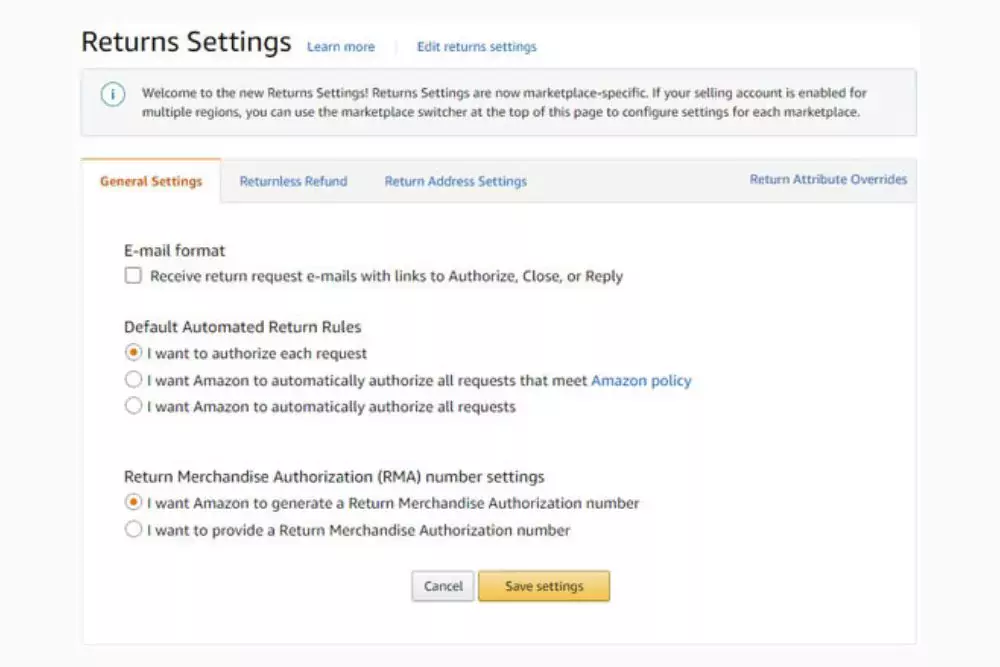Amazon Return Policy Guide: Easy Returns Explained

In the vast world of online shopping, understanding the intricacies of the Amazon return policy is crucial for both buyers and sellers alike. This comprehensive guide aims to demystify the processes, terms, and conditions, providing you with the knowledge to navigate Amazon returns confidently.
Understanding Amazon’s Return Policy
Amazon’s commitment to customer satisfaction is reflected in its return policy. This section delves into the foundational aspects that form the backbone of this policy, emphasizing the importance of transparency and trust.
The Foundation of Customer Confidence
Amazon’s customer-centric approach builds confidence among shoppers. Understanding the policy’s core principles is crucial for both buyers and sellers in fostering a positive shopping experience.
What are the reasons customers return item on amazon ?
Customers return products on Amazon for a variety of reasons, similar to those in general retail. Here are some specific reasons for returns on Amazon:
- Defective or Damaged Items:
- Customers may receive products that are defective or damaged during shipping. This can include electronic devices, fragile items, or anything susceptible to damage.
- Incorrect Product or Description:
- Sometimes, customers receive the wrong product or a product that doesn’t match the description on the Amazon listing. This can be due to errors in picking and packing.
- Size and Fit Issues:
- For clothing, footwear, or accessories, customers may return items due to sizing issues. This is common in online shopping where customers cannot try on items before purchasing.
- Changed Mind or Unwanted Items:
- Customers might decide they no longer want the product, or it doesn’t meet their expectations. This can be influenced by factors such as impulse buying, buyer’s remorse, or finding a better deal elsewhere.
- Late or Delayed Deliveries:
- If a product doesn’t arrive within the expected delivery window, customers may choose to return it, especially if the delay causes inconvenience.
- Issues with Quality or Performance:
- Customers may return items if they find the quality or performance doesn’t meet their standards. This can apply to a range of products, from electronics to household goods.
- Not as Advertised:
- If the product received significantly deviates from what was advertised on the Amazon platform, customers may return it due to false advertising or misrepresentation.
- Return Fraud:
- In some cases, customers may engage in fraudulent activities, such as returning a used item in place of a new one, leading to returns.
It’s worth noting that Amazon’s customer-centric policies, including its easy return process, can also contribute to a higher volume of returns compared to some other platforms
How to find out why customers are returning product on amazon
To find out why customers are returning a product on Amazon, you can utilize several methods and tools available on the platform. Here are some strategies:
- Customer Reviews:
- Check the product’s customer reviews on the Amazon product page. Look for common themes or issues raised by customers. This can provide insights into specific problems or concerns that lead to returns.
- Return Reason Codes:
- Amazon provides return reason codes for each return. Sellers can access this information in their seller account. Analyze these codes to understand the primary reasons customers are returning the product. Common codes include “Defective,” “Item not as described,” or “Changed my mind.”
- Customer Feedback and Messages:
- Engage with customers directly through the messaging system on Amazon. Reach out to customers who have left negative reviews or returned the product and ask for specific feedback. This can provide valuable information about their experience.
- Amazon Seller Central Analytics:
- Utilize the analytics tools available in Amazon Seller Central. Look for patterns or trends related to returns, such as spikes in return rates during specific time periods or for particular products.
- Product Testing and Quality Control:
- Conduct thorough testing of your products before listing them on Amazon. Address any issues related to quality, performance, or functionality. This proactive approach can reduce the likelihood of returns due to product defects.
- Improve Product Descriptions:
- Ensure that your product listings accurately describe the item, its features, and specifications. Clear and detailed product information can help set customer expectations correctly, potentially reducing returns due to misunderstandings.
- Monitor Customer Feedback on Social Media:
- Keep an eye on social media platforms for mentions of your products. Customers might share their experiences, including reasons for returns, on platforms like Twitter or Facebook.
- Competitor Analysis:
- Analyze customer reviews and returns for similar products from other sellers. This can provide insights into common issues within a particular product category.
- Collaborate with Amazon Customer Service:
- Work closely with Amazon Customer Service to gather additional information about returns. They may be able to provide more context or details about specific return cases.
By combining information from customer reviews, return reason codes, direct communication with customers, and analytical tools, you can gain a comprehensive understanding of why customers are returning a product on Amazon. Use this information to make improvements to your product, listings, and customer service processes.
How do I return an item to Amazon: Step-by-Step Guide
Returning a product on Amazon shouldn’t be a daunting task. This comprehensive step-by-step guide breaks down the process a return, ensuring a hassle-free return experience.
Step 1: Log into Your Amazon Account

Step 2: Go to Your Orders

Step 3: Select the Item You Want to Return

Step 4: Choose the Reason

Step 5: Select Your Preferred Return Method

Step 6: Print Your Return Label and Packaging Instructions

Key Points to Note in Amazon for returns
While initiating a return is straightforward, understanding key policy points ensures a smooth and informed return process.
Time Frame: The Amazon Return Window Explained
Amazon’s return window is the timeframe within which you can return a product. Familiarize yourself with this period to avoid any complications when initiating a return.
Return Eligibility Criteria
Not all items may be eligible for return. Unpack the criteria that determine whether a product is returnable, ensuring you meet the necessary conditions.
Returning Items Sold by Third-Party Sellers
When dealing with third-party sellers, the return process may vary. Uncover the specifics of returning items purchased from independent sellers on the Amazon platform.
Refunds and Replacement Process
What happens after you initiate a return? Delve into the refund and replacement process to know what to expect and how Amazon handles these situations.
Common Questions About Amazon Returns
Clear common doubts and misconceptions about Amazon returns. From return shipping fees to eligibility, get answers to questions that may
What to do with your returns
Once you’ve initiated a refund on Amazon and shipped the item back, there are a few things to keep in mind regarding what happens next:
- Tracking the Return:
- After you’ve shipped the return, you can track its status on the Amazon website. This will help you know when the return has been received and when the refund or replacement is processed.
- Refund Process:
- If you requested a refund, once Amazon receives the returned item, they will process the refund. The timing of the refund can vary, but you should receive the credit back to your original payment method.
- Replacements and Exchanges:
- If you requested a replacement or exchange, Amazon will send the new item to you once they receive and process the rerfund
- . You’ll receive notifications regarding the status of your replacement.
- Checking Your Amazon Account:
- Keep an eye on your Amazon account for updates. You can view the status of your return and any associated refunds or replacements in the “Your Orders” section.
- Unused Amazon Gift Card Balance:
- If you used an Amazon gift card or gift certificate for the purchase, the refunded amount will be credited back to your gift card balance.
- Restocking Fees:
- Be aware that certain items may be subject to restocking fees, especially if they are not returned in their original condition or if they are non-defective. Review the specific return policy for the item you’re returning.
- Amazon Locker:
- If you used an Amazon Locker for the return, follow the instructions provided during the return process to complete the return. Once the return is processed, you will receive notifications regarding the status.
- Contact Amazon Customer Service:
- If you encounter any issues or have questions , you can contact Amazon customer service. They can provide assistance and clarification on the return process.
It’s important to note that the specifics of the process can depend on the type of item, the reason for the return, and Amazon’s policies at the time of your transaction
Amazon Return Policy vs. Other E-commerce Platforms
Comparing Amazon’s return policy with other e-commerce platforms sheds light on the unique features and benefits that set Amazon apart in terms of customer satisfaction.
A Customer-Centric Approach
Discover how Amazon’s customer-centric approach to returns differentiates it from other e-commerce platforms. The emphasis on satisfaction creates a shopping environment built on trust.
Striking the Balance: Buyer and Seller Protections
Amazon’s return policy strikes a delicate balance, offering both buyers and sellers protection. This section explores the equilibrium achieved, ensuring a fair and transparent process for all parties involved.
Legal Considerations and User Rights
Understanding the legal aspects of Amazon’s return policy is crucial for both buyers and sellers. Explore user rights, compliance, and how Amazon ensures a fair and transparent process.
Ensuring Fair Practices
Amazon’s commitment to fair practices is evident in its return policy. This section delves into the legal framework, ensuring that both buyers and sellers are treated equitably.
Transparency in Transactions
Transparency is a cornerstone of Amazon’s success. Uncover how the platform maintains transparency in transactions, fostering a sense of security and reliability.
Success Stories: Navigating Amazon Returns Effectively
Real-world success stories showcase how individuals and businesses navigate Amazon returns effectively, emphasizing the importance of a customer-focused approach.
Strategies for Sellers: Building Customer Loyalty
Successful sellers on Amazon share strategies for navigating returns effectively while building customer loyalty. Learn from these stories to enhance your own business practices.
Buyer Experiences: Positive Resolutions
Buyers’ positive experiences with Amazon returns highlight the platform’s effectiveness in resolving issues. These anecdotes serve as a testament to the customer satisfaction Amazon aims to achieve.
Future Changes and Updates to Amazon’s Return Policy
In the ever-evolving landscape of e-commerce, staying informed about future changes to Amazon’s return policy is vital. Anticipate updates and prepare for an even more streamlined return experience.
Adapting to Technological Advances
Explore how technological advancements may shape the future of Amazon returns. From improved tracking systems to enhanced customer communication, anticipate positive changes.
Sustainable Practices: Eco-Friendly Returns
As environmental consciousness grows, Amazon is likely to implement more sustainable return practices. This section explores the potential for eco-friendly packaging and reduced waste in the return process.
Conclusion
Demystifying the Amazon return policy empowers shoppers to make informed decisions and sellers to provide a seamless customer experience. By understanding the process, adhering to key policy points, and anticipating future changes, both buyers and sellers contribute to a thriving and trustworthy e-commerce ecosystem.
In conclusion, Amazon’s return policy is not just a set of rules; it’s a commitment to customer satisfaction and fair business practices. As you navigate the world of online shopping on Amazon, armed with the insights from this comprehensive guide, you’ll find that returns become not just a part of the process but an opportunity for positive engagement and growth.



